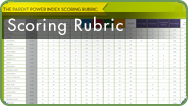About the Parent Power Index
“Parent Power” means giving parents Access to quality educational Options and providing them with good Information to make smart decisions about their children’s education. The Parent Power Index (PPI) measures the ability in each state of a parent to exercise choices – no matter what their income or child’s level of academic achievement – engage with their local school and board, and have a voice in the systems that surround their child. The Parent Power Index gives parents an interactive tool to discover whether the state affords them power –and if not, what they can do to get it.
The Center for Education Reform has nearly two decades under its belt working to empower parents. And since 1999, CER has been providing Parent Power!, a program aimed at helping parents make sense of schooling. Parent Power! started out as a quarterly magazine, but as the World Wide Web grew, so did Parent Power! CER has helped develop and network over 10,000 grassroots groups all across the country.
The Parent Power Index is CER’s vision for the next generation of Parent Power!
The Index does not score whether a state’s education laws are good or bad, but rather, for example, if those policies allow a maximum number of parents to actually make choices. The following “elements of power” provide a framework for evaluating and scoring state policies and practices that either ensure or limit Parent Power in the U.S.
Scoring Rubric
The formula was created with individualized scores for each Element of Power, each converted to a four-point scale and combines to make up an averaged GPA which was then converted to a percentage of power for each state. Charter Schools and School Choice were weighted as 75% of the overall grade. Bonus points are calculated based on whether a state has a parent trigger law, and whether or not information on schools and school board elections are transparent, or available to the public. States earn .05 for having a parent trigger law and .01 each for transparency of schools and school board elections, for a possible bonus total of .07. Ties are broken based on choice implementation and how influential these categories are on affording parents true power. Bonus points of .05 were awarded to Alabama for its March 2013 passage of a tax credit law and to Washington for adopting a charter school law in Nov. 2012.
 The summary data can be found here.
The summary data can be found here.Elements of Power

Charter Schools
The degree to which states offer or provide for a significant number of charter opportunities to families, is another important piece of parent power. States that have stronger laws ensure greater access to quality charter school options. CER’s Charter School Laws Across the States was used to determine this element’s score on the Parent Power Index.

School Choice
School choice programs are evaluated on their potential to reach all children across a state. Programs where significant numbers of parents throughout the state can obtain scholarships and other forms of state support to send their kids to schools of their choice score higher than those that have limitations based on geography, appropriations, categories of need or appropriations. CER’s School Choice Today: Voucher Laws Across the States and School Choice Today: Education Tax Credit Scholarships Ranking & Scorecard are used to determine this element of power.

Teacher Quality
Teacher quality is an equally important facet of the Parent Power Index. States that ensure high quality individuals can teach without barriers to entry score higher. States where teacher effectiveness is judged on objective data fair better than states with very little focus on attracting retaining and rewarding teachers. This portion of the Parent Power Index is derived from The National Council on Teacher Quality’s detailed analysis in its annual State Teacher Policy Yearbook.

Transparency
States are judged based on the transparency and accessibility of data for the average person. States that provide comprehensive and user-friendly report cards, share information about school options and explain how well their schools perform can gain points in their overall PPI. Similarly, states where parents are able to vote in school board races during the general election cycle, as opposed to off times of the year when turnout is low, tend to afford parents more power in their decision-making.

Online Learning
Online learning is a relatively new component of education reform, and for most states, is still a work in progress. The data and analysis for this element is attributed to Digital Learning Now’s evaluation of state policies and their alignment to the 10 Elements of High Quality Digital Learning.
Other Factors

Parent Trigger
The increasingly popular Parent Trigger Laws provide parents and educators the opportunity for parents to turn around failing schools. As this is a significant lever for change, the seven states that afford parents this kind of power earned a boost on the Index. Parent Revolution is a valuable resource on existing trigger states.

Governors
Whether state executives are pro-reform or not is important in ensuring parents have power. While governor or candidate positions are not factored into a state’s overall PPI score, it’s clear that states with more reform-minded leaders have policies in place that result in greater parent power. Check out CER’s Education Fifty.

Media Reliability
The media plays a big role in informing the public and policymakers on education. But when the reporting lacks balance, context and sound data, it is no longer a reliable source for parents to make smart decisions about their kids schooling. Media reliability is also not factored into a state’s Parent Power Index score, but the Media Bullpen provides a critical eye to help parents better understand the complexity of the issues being reported and gives them numerous tools to be a stronger voice in education reporting.

